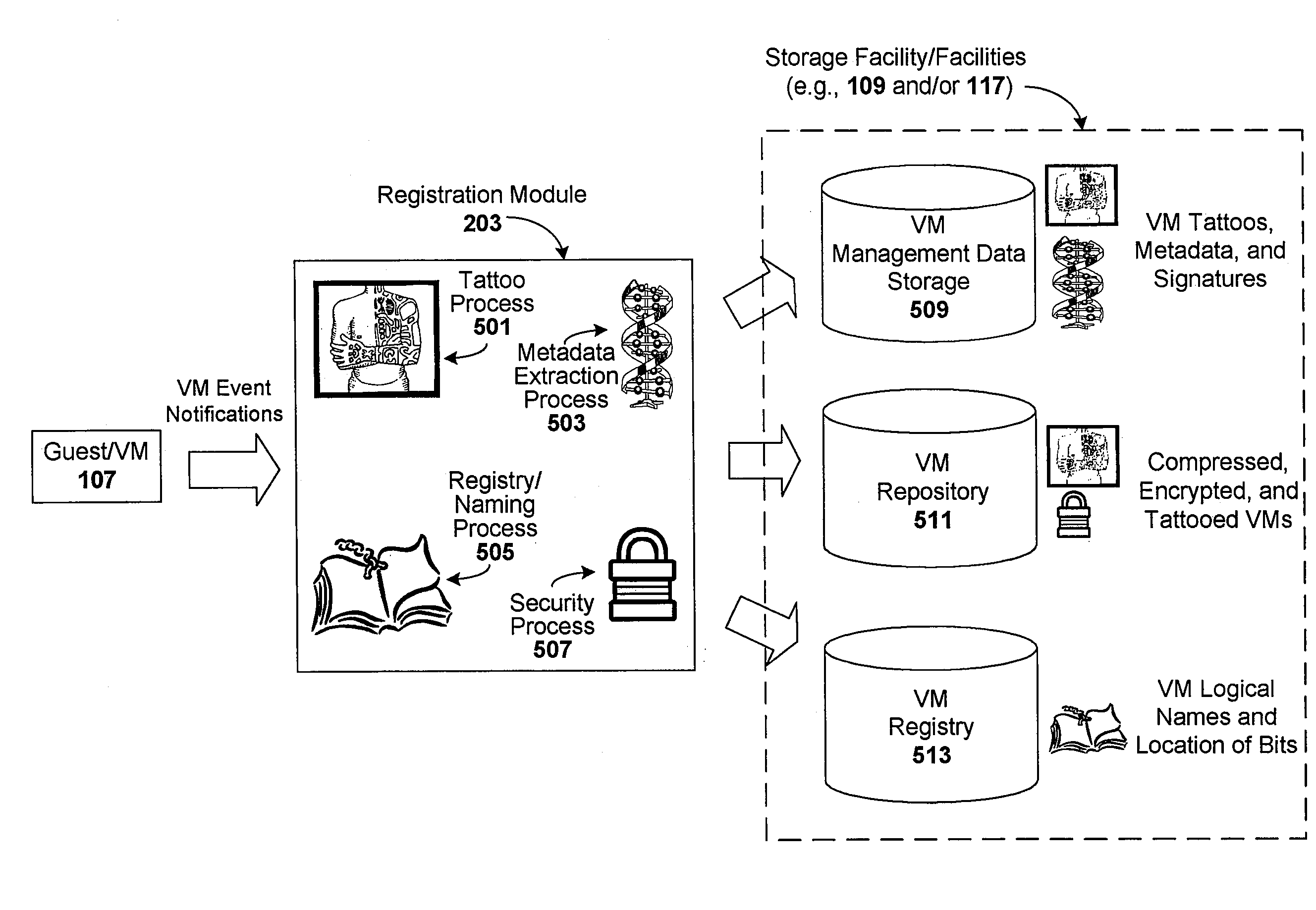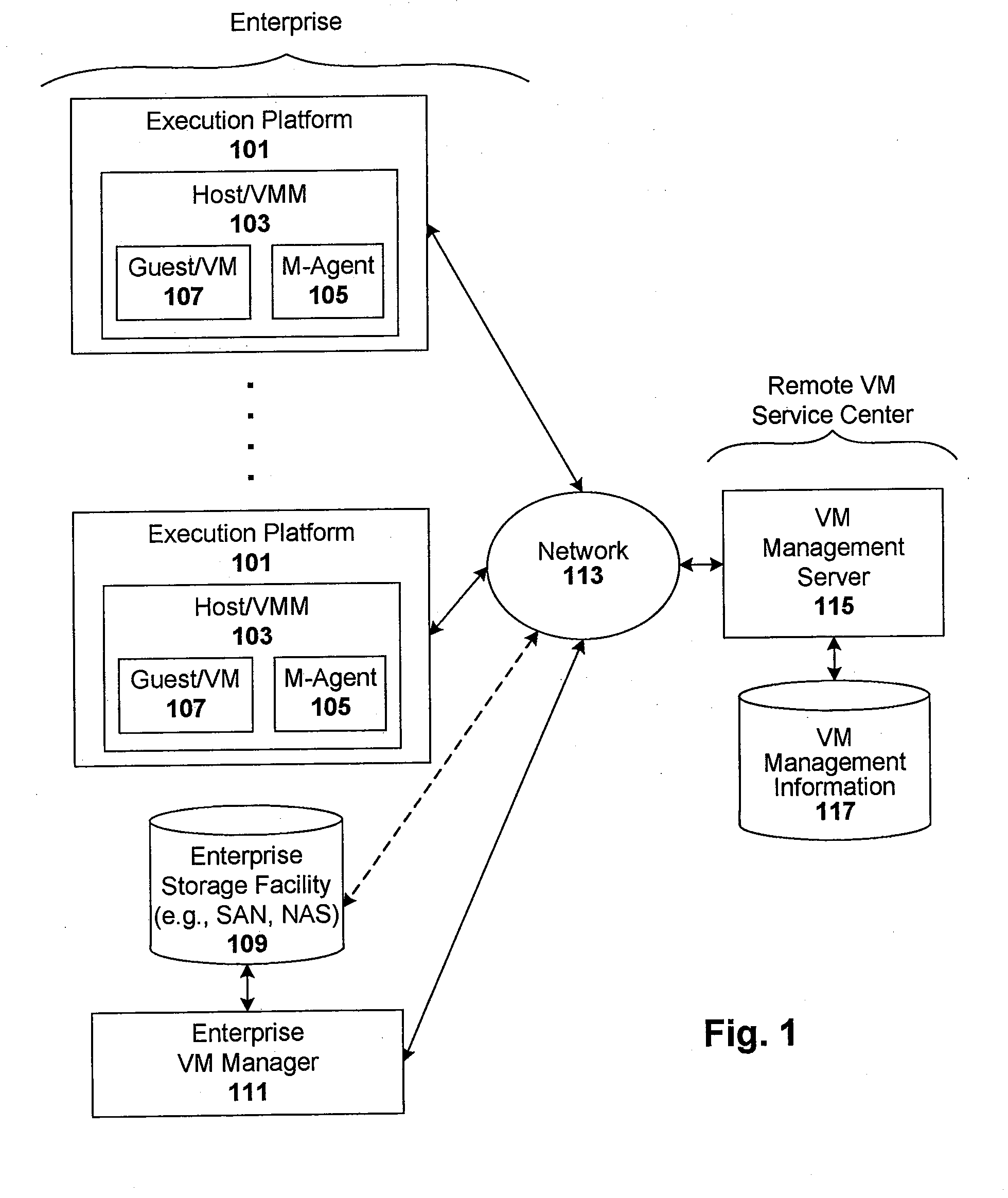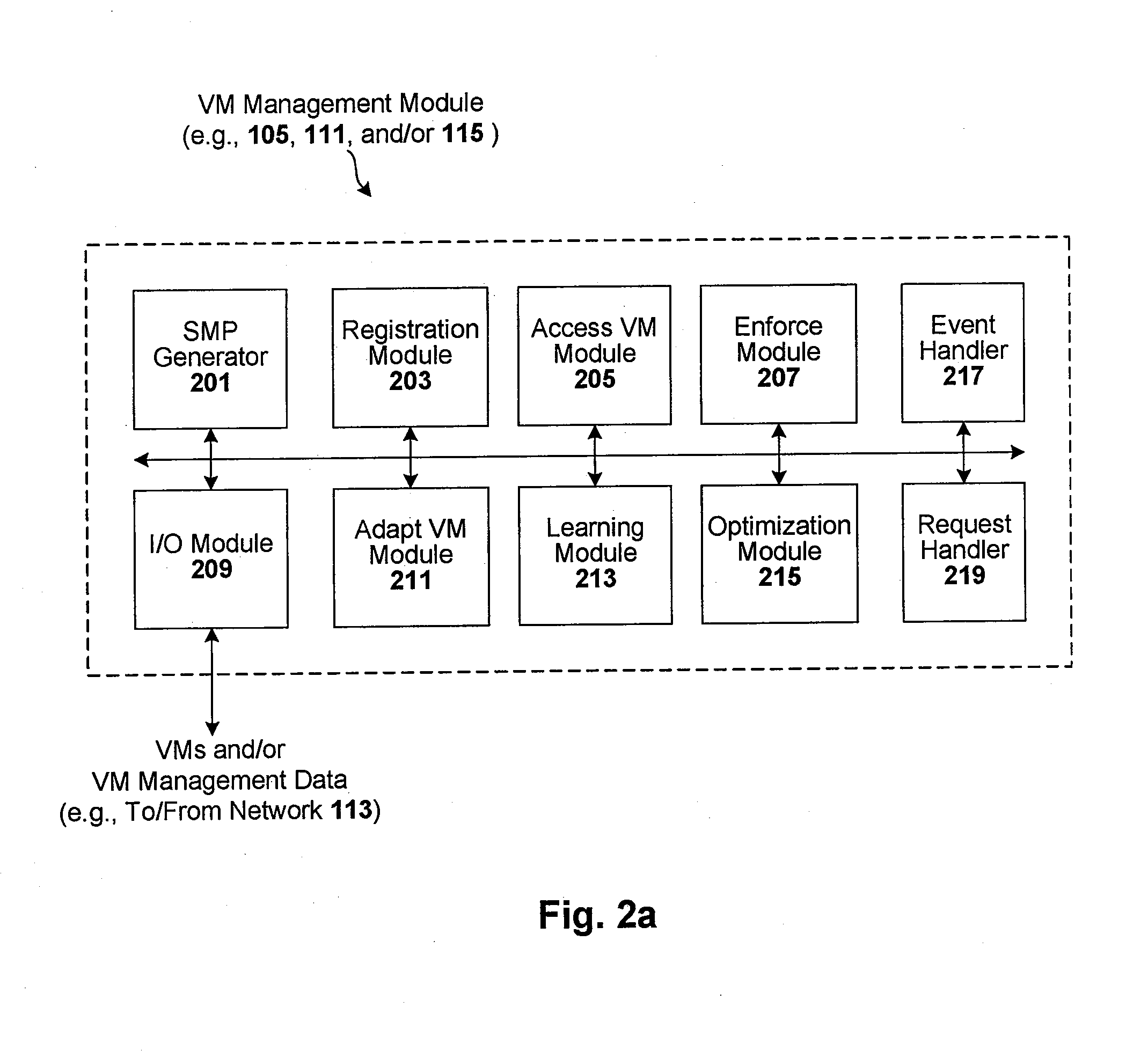[0009]One embodiment of the present invention provides a method for enforcing a virtual machine (VM) compliance scheme. The method includes getting compliance policies regarding a target VM, and prior to executing the target VM, applying the compliance policies against the target VM to determine if the target VM is compliant with the VM compliance scheme. In one such case, at least one or more compliance policies with which the target VM must comply to execute are signature-based policies, and applying the compliance policies against the target VM includes comparing a system signature against at least one signature-based policy, wherein the system signature is based on the one or more signatures reflective of VM content. Here, the comparison generates a result upon which a compliancy determination is made. In another such case, applying the compliance policies includes comparing signatures reflective of VM content against at least one of blacklist signatures, whitelist signatures, and greylist signatures. In another such case, and in response to the target VM being compliant with the VM compliance scheme, the method may include executing the target VM in an execution platform. In another such case, the method includes preliminary steps of intercepting a request to start, stop, pause, move, resume, clone, create new, and / or deploy from template the target VM, and preventing the target VM from so executing until the target VM is determined to be compliant with the VM compliance scheme. In another such case, and in response to at least one of the target VM and an execution platform of the target VM being non-compliant with the VM compliance scheme, the method may include taking remedial action. The remedial action may include, for example: preventing the target VM from executing until the target VM is determined to be compliant with the VM compliance scheme; allowing the target VM to execute with warnings issued to alert an operator console or auditing system of the non-compliancy; issuing an alert with details about why VM execution was prevented, including which policy or policies disqualified the target VM from execution; allowing the target VM to execute and correct non-compliances to bring itself into compliance; allowing the target VM to execute in an isolated environment; scheduling at least one of an agent or process to carryout remedial action; registering the target VM for use in a managed system associated with the VM compliance scheme; adjusting security settings; deleting unauthorized content; obtaining necessary licensing; restricting access permissions, so that the target VM can only access certain content, resources, and areas of the managed system; and / or at least one of adding, updating, and deleting user account information, so as to limit account authority associated with the target VM. In another such case, and prior to executing the target VM, the method may include applying one or more of the compliance policies to an execution platform of the target VM to determine if the execution platform is compliant with the VM compliance scheme. In response to the execution platform not being non-compliant, the method may further include preventing the target VM from executing. In another such case, and prior to executing the target VM, the method includes applying one or more of the compliance policies to a requesting user of the target VM to determine if the user is compliant with the VM compliance scheme. In response to a detected non-compliancy associated with the requesting user, the method may further include preventing the target VM from executing. In another such case, at least one of the compliance policies requires the target VM to be registered before it is used. Here, the method may further include determining (prior to executing the target VM) if the target VM is registered for use. In response to the target VM not being registered for use, the method may further include preventing the target VM from executing until the target VM is registered. In another such case, the method may include checking license information against metadata indicating which applications are installed on the target VM, and in response to one or more requisite licenses not being available, preventing the target VM from executing until requisite licenses are available. In another such case, at least one of the compliance policies requires the target VM to operate during a specified time window. Here, the method may further include determining (prior to executing the target VM) if the time window is satisfied. In response to the time window not being satisfied, the method may further include preventing the target VM from executing until the window is satisfied. In another such case, at least one of the compliance policies requires the target VM to operate in a particular context (e.g., production or test or development). Here, the method may further include determining (prior to executing the target VM) if the target VM will be used in the context. In response to the target VM not being used in the context, the method may further include preventing the target VM from executing. In another such case, the method is applied to a plurality of target VMs as part of an initiation of those VMs into a managed system associated with the VM compliance scheme. In another such case, the target VM can only be executed by an execution platform that is included in a managed system associated with the VM compliance scheme. In another such case, an execution platform that is included in a managed system associated with the VM compliance scheme will only execute VMs registered for use in the managed system. In another such case, applying the compliance policies occurs after a VM start request is received and prior to executing the target VM in response to that VM start request. In another such case, the m method includes arbitrating (prior to applying the compliance policies) the compliance policies for priority, conflict, or deadlocks. In another such case, the method may include getting metadata associated with a target VM, wherein applying the compliance policies includes applying the compliance policies against the metadata. In one such particular case, the metadata is content metadata associated with the target VM, and getting compliance policies regarding the target VM includes getting compliance policies regarding content of the target VM. In another such particular case, getting metadata includes accessing a management partition in the target VM, the management partition for storing management data including the metadata. In another such particular case, getting metadata includes accessing an enterprise storage facility for storing management data including the metadata. In another such particular case, getting metadata includes accessing a remote VM management server for storing management data including the metadata. In another such particular case, getting metadata includes making a copy of the target VM, executing the VM copy in an isolated environment, interrogating the executing VM copy to extract the metadata, and storing the metadata. Here, getting metadata further includes (prior to the executing step) modifying the VM copy to make the VM copy executable, and (after the interrogating step) stopping the executing VM copy, and discarding the VM copy. In another such particular case, getting metadata includes exporting the target VM to a portable storage media, mounting the VM portable storage media as a virtual drive at a test location, interrogating the target VM to gather the metadata, and storing the metadata. In another such particular case, getting metadata includes starting an agent on an execution platform of the target VM, mounting one or more disk files of the target VM to a Network File System (NFS) associated with the execution platform, accessing (by the agent) the one or more disk files, interrogating (by the agent) the one or more disk files to gather the metadata, and storing (by the agent) the metadata. Here, getting metadata further includes unmounting one or more disk files of the target VM from the NFS. In another such particular case, getting metadata includes extracting the metadata from the target VM in real-time. In another such particular case, the metadata is pre-extracted metadata that is stored and accessible to the method. The metadata may include, for example, physical and logical metadata. In another such particular case, getting metadata includes attempting to read the metadata from the target VM. In response to the metadata being unavailable on the target VM, the method may include attempting to read the metadata from a storage location external to the target VM. In response to the metadata being unavailable externally to the target VM, the method may include extracting the metadata in real-time. In another such particular case, applying the compliance policies against the target VM further includes comparing signatures of the metadata against at least one of blacklist signatures, whitelist signatures, and greylist signatures. In another such particular case, at least one or more compliance policies with which the target VM must comply to execute are signature-based policies. Here, applying the compliance policies against the target VM may include comparing at least one signature of the metadata against at least one signature-based policy, wherein the comparison generates a result upon which a compliancy determination is made. The signatures used in comparisons can be computed, for example, using one or more hashing functions (e.g., MD5 or other suitable signature generation process). Fuzzy matching can be used in the comparison to allow for degrees of matching. The VM can be, for example, a virtual application, virtual appliance, or other such virtual system or special purpose virtual process. In all the above particular embodiments, execution of a target VM includes any action taken by a target VM in response to an intercepted request for action according to the method described. Examples of execution include starting a VM, stopping a VM, pausing a VM, moving a VM, cloning a VM, creating a new VM, deploying a VM from a template, or performing any other suitable action on a target VM.
 Login to View More
Login to View More  Login to View More
Login to View More 


